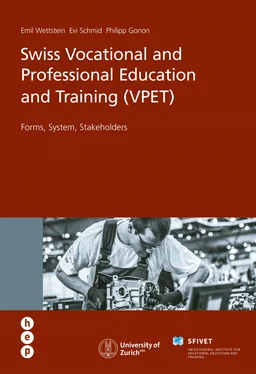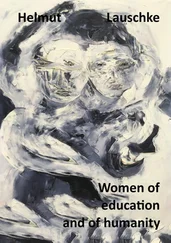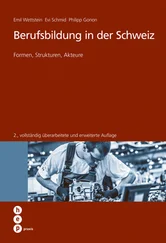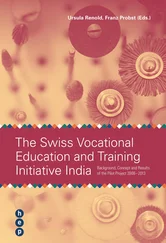1.8.1 Extension of the duration of the VET programme
Young people who, on account of impairments, cannot complete a VET programme during the regular training period have the possibility of applying to the cantonal VET office for an extension of the programme duration. The basis for this is provided by the Federal Vocational and Professional Education and Training Act VPETA, which stipulates that the duration of the VET programme for young people “with learning difficulties or disabilities” can be extended appropriately (VPETA, 2002, Art. 18, para. 1; on the reduction of the duration of a VET programme cf. Chapter 1.7, p. 50).
1.8.2 Support for the qualification procedure
People who, on account of an impairment or disability, need support for the qualification procedure can also apply for this:
“Candidates with disabilities shall be given the special aids or additional time that they may reasonably require” (Vocational and Professional Education and Training Ordinance, VPETO (Berufsbildungsverordnung, BBV; VPETO, 2003, Art. 35 para. 3). People who, after repeating the qualification procedure, do not successfully pass can have a competence record issued (cf. Chapter 3.8.1, p. 172).
1.8.3 Compensating for disadvantages of people with disabilities in VPET
In 2013, the Schweizerisches Dienstleistungszentrum Berufsbildung or SDBB (Swiss Service Centre for Vocational Education and Training) published a report on “Nachteilsausgleich für Menschen mit Behinderung in der Berufsbildung” (Compensating for disadvantages of people with disabilities in VPET). This means specific measures to compensate for disadvantages caused by disabilities, i.e. adaptations to the training process and qualification procedure whereby the cognitive and technical requirements have to correspond with the specifications listed in the VET ordinance for the respective profession, however (SDBB, 2013). On the basis of the SDBB report, the Kommission berufliche Grundbildung (VET commission) of the Schweizerische Berufsbildungsämter-Konferenz SBBK (Swiss Conference of cantonal VET offices) issued a recommendation on how to coordinate the activities at vocational schools and at host companies with measures to compensate for disadvantages in the different cantons. This also includes a form which the affected learners can fill out and submit when signing the apprenticeship contract. Before teaching begins, all people involved in the training need to be informed about visual or hearing impairments, dyslexia and dyscalculia, physical, psychological or mental disabilities or attention deficit (hyperactivity) disorder (ADHD). They have to discuss and come to an agreement on the measures necessary for a possible learning disability or other disability so that the learners can successfully complete their training. Measures which come into question to compensate for disadvantages include, for example, providing additional aids or equipment or extending the examination period.
1.8.4 Supported education
The concept of supported education has increasingly attracted attention. It refers to the support of young people with disabilities or impairments to help them complete a VET programme in the regular labour market (cf., for example, Schaufelberger, 2013). This concept assumes that people with impairments are also capable of completing training and carrying out gainful employment provided that appropriate activities can be found in a suitable training or working environment and the required support is available. Such a supported form of VET occasionally gives rise to major challenges for the coordination and cooperation of the host company, vocational school and other involved bodies and people. Supported education is based on the concept of supported employment (cf. Doose, 2012).
1.8.5 Non-formal one or two-year apprenticeship (Anlehre)
The non-formal one or two-year apprenticeship (Anlehre) was introduced by law in 1978 and was aimed at “especially practically gifted young people” (VPETA, 1978, Art. 49) who did not meet the required prerequisites for a regular apprenticeship. Instruction at vocational school was in small classes and was predominantly practice-oriented. The VET programme of the non-formal apprenticeship, which usually lasted two years, was not standardised but rather an individual training plan defined by the learner and the apprenticeship trainer. There were also no regular, standardised final examinations: the experts visited the learners for a day at the host company and checked if the apprentice had learned what had been set out in the individual VET programme (visual inspection). A supplement to the official certificate listed the skills and abilities that had been acquired.
Even if the share of learners in this informal VET programme, measured by the total share of young people in VET, had only reached a good two per cent by the end of the 1990s (Wettstein, 1999), it was an important programme for many young people. However, it did not offer the young people any regulated advancement or access to continuing education and training opportunities. In addition, the labour market success of people who completed a non-formal programme was low compared with people without any upper-secondary level qualification (Schweri, 2005).
As part of the most recent revision of the Federal Vocational and Professional Education and Training Act, the non-formal apprenticeship lost its legal basis: since 2005, such programmes have been continually replaced by two-year VET programmes with Federal VET Certificate (zweijährige berufliche Grundausbildung mit eidg. Berufsattest, EBA). In mid-2015, there were already more than 50 ordinances in force for two-year VET programmes with Federal VET Certificate, and other ordinances will follow. For professions for which there is not yet any VET programme with Federal VET Certificate, non-formal programmes could be offered until the end of 2014 at the latest. For all other professions, the last official beginning of non-formal one or two-year programmes was in 2012 (SERI, 2013j). In that year, there were still around 600 young people who began a non-formal programme (Federal Statistical Office; FSO, 2013h).
On various occasions the fear has been expressed that the two-year VET programmes with Federal VET Certificate make higher demands than the previous non-formal programmes (e.g. Aeschbach, 2006; Kammermann & Hofmann, 2008; Scherrer, 2008). This assumption is comprehensible since VET programmes with Federal VET Certificate, unlike the non-formal programmes, are oriented towards a standardised VET programme. However, this hypothesis cannot be empirically assessed until the non-formal programmes have definitively come to an end (Stern et al., 2010).
1.8.6 VET with support from the Disability Insurance (Invalidenversicherung or IV)
According to the Federal Act on Disability Insurance or DI (Bundesgesetz über die Invalidenversicherung), youths and young adults with impairments or disabilities are entitled to support from the disability insurance so that they can complete a VET programme. The DI used to support young people doing a “Practical training” (cp. 1.8.7). But other young people who are doing a regular VET programme may also need the support of the DI, for example if they are dependent on specific measures on account of a physical disability. An example is young people with a hearing impairment who attend vocational school classes at the Berufsschule für Hörgeschädigte BSFH (Vocational School for the Hearing-Impaired) in Zurich.
1.8.7 Practical training according to Insos
The practical training according to Insos (Praktische Ausbildung nach Insos, PrA) is offered by the Nationaler Branchenverband der Institutionen für Menschen mit Behinderung, Insos (National Umbrella Organisation of Institutions for People with Disabilities), under the responsibility of the Bundesamt für Sozialversicherungen BSV (Federal Social Insurance Office FSIO).
Читать дальше












